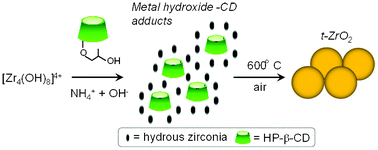Hydroxypropyl-β-cyclodextrin as a versatile additive for the formation of metastable tetragonal zirconia exhibiting high thermal stability†
Abstract
Single-phase tetragonal zirconium oxides with enhanced phase stability were successfully synthesized by a precipitation procedure, using hydroxypropyl-β-cyclodextrin (HP-β-CD) as a new macromolecular additive. The samples were prepared in the presence of controlled amounts of HP-β-CD by precipitation of a zirconium oxychloride solution in an aqueous ammonia solution and then annealed at 600 °C to produce the pure tetragonal phase. The as-prepared ZrO2 particles are composed of nanocrystallites with coherent scattering region sizes of the order of 40 nm at temperatures as high as 600 °C. The formation of the t-phase was investigated at different stages of the process by XRD, TGA–TDA, FTIR and conductivity measurements. The process of crystallization of the hydrous zirconia precursor was found to be retarded by the binding of HP-β-CD to the zirconium metal centres, further leading to structure-controlled t-ZrO2 nanocrystals with increasing temperature up to 800 °C. The beneficial effect of HP-β-CD was related to its ability to be partially deprotonated in the aqueous ammonia solution and interact with the Zr(IV) species in the early stage of the synthesis. This hypothesis was supported by additional controlled syntheses of materials using other cyclodextrin derivatives.


 Please wait while we load your content...
Please wait while we load your content...